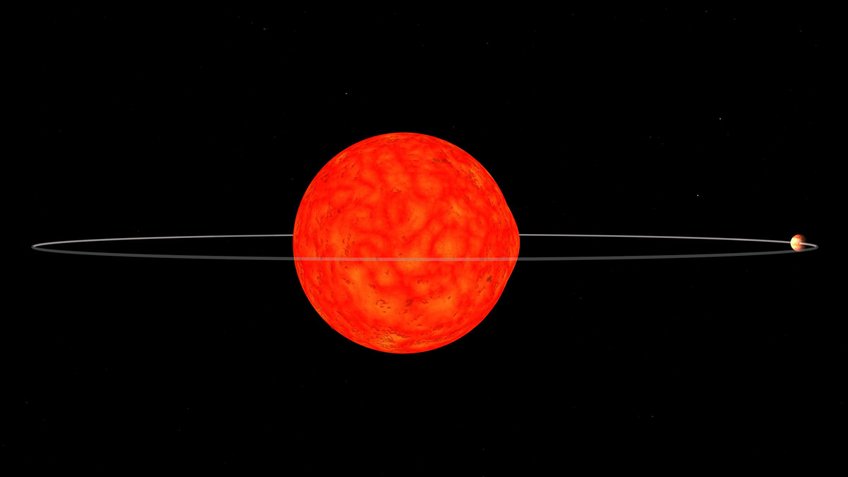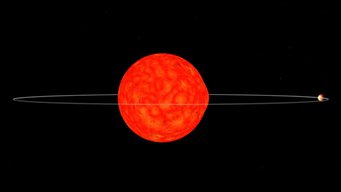Doomed Planet Confirmed
Kepler-91b is doomed: In an estimated 55 million years it will be engulfed by its host star, a red giant. Recent studies, though, suggested a completely different type of doom, claiming there might not be such a thing as the planet Kepler-91b at all. Instead, according to those studies, what had been observed might instead be a fairly dim star. Now new observations with the CAFE spectrograph at Calar Alto observatory have settled the case: Kepler-91b is indeed a planet. The result also validates the method used for the original detection, an unusually detailed analysis of light received from the planet's host star.
| Questions and Answers | High-resolution Images |

When a group of astronomers including Amelia Bayo and Luigi Mancini of the Max Planck Institute for Astronomy announced the discovery of the planet Kepler-91b in December 2013, the main point of interest was the planet's imminent demise: The observations showed that an estimated 55 Million years from now – a mere blink of the eye compared to usual astronomical time scales – the planet would be engulfed by its parent star, a red giant. The same fate awaits the Earth in about five billion years, when our Sun will become a red giant star es well.
The astronomers, led by Jorge Lillo of the Center of Astrobiology (CAB) in Madrid, had employed an unusual method to detect Kepler-91b, making use of data from NASA's Kepler Space Telescope.
The astronomers had concentrated on a planet candidate, designated KOI2133.01, that had not then be confirmed as a planet. They had looked very closely at the changes in the star's brightness, carefully looking for effects that are not usually included in the analysis, which include starlight reflected by the planet, or brightness effects caused by tiny deformations of the star caused by the planet's gravitational pull. They concluded that the star indeed had a planet, which was given the designation Kepler-91b.
Detailed light curve analyses are comparatively new and rare – and for a while, it was far from clear whether or not they were indeed reliable enough to detect planets. In fact, two other groups of scientists (Esteves et al. 2013, Sliski & Kipping 2014) argued that Kepler-91 b might not be a planet at all; instead, it could be a dim star or brown dwarf.
Now spectroscopic observations with the newly operational spectrograph CAFE (Calar Alto Fiber-fed Echelle spectrograph) at Calar Alto observatory in Spain have provided independent evidence that Kepler-91b is indeed a planet. It has only 10% more mass than Jupiter; a value that fits in well with the results of the earlier analysis. In fact, this is the first firmly confirmed planet that has been detected by brightness variations and is orbiting a red giant star.
Thomas Henning, a director at the Max Planck Institute for Astronomy, who participated both in the original analyses and the recent confirmation, says: "This is an exciting result. Our discovery of Kepler-91b demonstrated that observations by the Kepler telescope contain a wealth of information that is missed by conventional analyses of brightness variations. I'm delighted that our findings have now been confirmed by independent observations."
The observations are of particular significance for the staff at Calar Alto Observatory: CAFE, operational since 2011, is the first instrument built directly at the observatory, and this has been the first time an exoplanet has been confirmed with data from Calar Alto. CAB senior staff member David Barrado, a former director of Calar Alto Observatory, comments: "CAFE has surprised us – it provides better data than we had hoped for, so we can use our observation time very effectively. We are still improving the calibration process, and have high hopes of improving CAFE performance even further."
The excellent performance of CAFE bodes well for the instrument's successor, CARMENES, currently under construction by a German-Spanish consortium that includes the Max Planck Institute for Astronomy, the Instituto de Astrofísica de Andalucía, and Landessternwarte Königstuhl (Heidelberg University). From 2016 on, CARMENES will search for Earth-like planets around reddish stars known as M dwarfs.
Background information
The work described here has been excepted for publication as Lillo-Box et al., "Radial velocity confirmation of Kepler-91b" in Astronomy & Astrophysics Letters.
The co-authors are J. Lillo-Box (Astrophysics Department, Center of Astrobiology, CSIC-INTA, Spain); D. Barrado (Astrophysics Department, Center of Astrobiology, CSIC-INTA, Spain); T. Henning (Max Planck Institute for Astronomy, Germany); L. Mancini (Max Planck Institut für Astronomie, Germany); S. Ciceri (Max Planck Institut für Astronomie, Germany); P. Figueira (Centro de Astrofísica, Universidade and Departamento de Física e Astronomia, Universidade do Porto, Portugal); N.C. Santos (Centro de Astrofísica, Universidade and Departamento de Física e Astronomia, Universidade do Porto, Portugal); J. Aceituno (Centro Astronómico Hispano-Alemán, Calar Alto Observatory, Spain); and S. Sánchez (Instituto de Astronomía,Universidad Nacional Autonóma, México)
Questions and Answers
What was new/unusual about the discovery of Kepler-91b?
From 2009 to 2013, the Kepler telescope monitored the brightness of 190,000 stars with unparalleled precision. A planet around one of those stars which occasionally passes directly between the star and an observer here on Earth will cause periodic dips in the star's brightness. The difficult bit is deciding which dips in brightness indicate the presence of a presence, and which are caused by other phenomena, such as dark spots on the star's surface. Once the Kepler telescope has found a planet candidate, further observations or further analysis are necessary. In most confirmed cases, the additional evidence is provided by spectroscopic observations, which reveal the periodic motion of the host star due to the planet's presence ("radial velocity method"); this has lead to the confirmation of almost a thousand planets. Recently, the Kepler team has also employed statistical methods to confirm stars with multiple planets – relying on the fact that it would be highly improbable for star spots and other effects to mimic the signal produced by a whole planetary system. Kepler-91b was found not by these standard methods, but by a more-than-usually detailed examination of the light-curve. This examination takes into account effects such as light produced by the planet; starlight reflected by the planet; deformations of the star produced by the planet's gravity, which cause brightness variations as the star shows us a larger or smaller profile, and brightness variations due to the star's motion caused by the planet's gravitational tug ("Doppler beaming"). So far, this type of analysis had only been used on a handful of planets (as opposed to the hundreds of planets confirmed by other means) – so it's an interesting development to see its predictions for Kepler-91b confirmed by the more standard radial velocity measurements, providing a validation of what promises to become an important tool in the arsenal of exoplanet studies.
Another unique aspect is that this is the first confirmed planet that has been detected by transit observations and is orbiting a red giant star. Transits for giant stars are very difficult to detect: These stars are so large and bright that the brightness fluctuations caused by the planetary transit are very small indeed. At least at present, Kepler-91b with observations of a transit as well as of its radial velocity, and orbiting a red giant star, is unique.
Which instruments and telescopes were used in these results?
The original analyses relied on light-curve data from NASA's Kepler Space Telescope. They also made use of observations with the AstraLux lucky imaging camera at the 2.2 m telescope at Calar Alto. The new measurements (radial velocity) were made by the CAFE spectrograph at the Calar Alto 2.2 m telescope.
Download area


